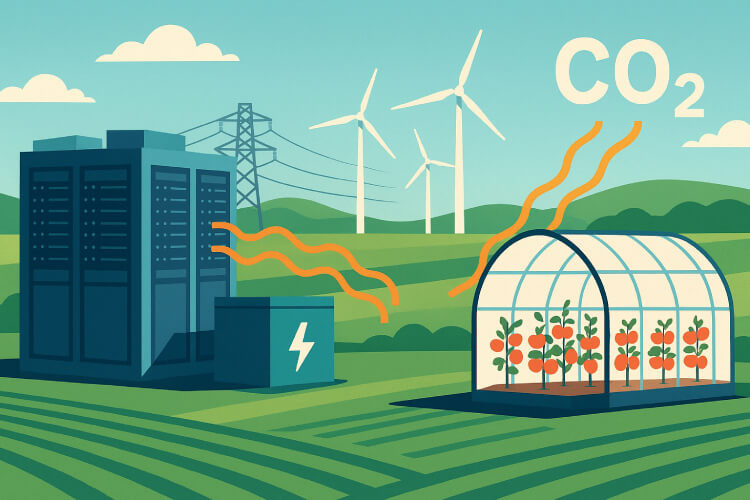Data Centers Meet Agriculture in Ohio’s Clean Energy Plan
Insights | 04-06-2025 | By Robin Mitchell

Key Takeaways:
- Data centres could account for 9% of U.S. energy consumption by 2030, driven by rapid growth in AI and cloud computing.
- Ohio is leading a new model by integrating microgrids with data centres, enhancing grid resilience while reducing dependency on fossil fuels.
- Waste heat and CO2 emissions from AI facilities are being reused to power local agriculture, creating year-round food production opportunities.
- This combined infrastructure model supports energy security, environmental sustainability, and rural economic revitalisation in a single system.
As AI and cloud computing continue to expand, data centers have become essential to our digital world—but that growth comes at a cost. Energy consumption, carbon emissions, and water usage are rising dramatically as these facilities multiply across the globe. The question of sustainability is no longer theoretical; it’s urgent and unavoidable.
So, what are the environmental consequences of our growing reliance on data centers? How are researchers and regions responding to the challenge? And could a solution lie in reimagining the very role of these power-hungry facilities?
The Datacenter Environmental Challenge
The rise of Artificial Intelligence (AI) and cloud-based services has escalated the importance of data centers in today's world. As businesses and individuals continue to rely more heavily on cloud infrastructure, the demand for data centers has surged. These massive facilities are now the backbone of nearly every online service we use, whether it's storing data, running AI algorithms, or simply powering the websites we visit daily.
With the rapid construction of data centers, new technologies are emerging, and so are fresh employment opportunities. As organisations scramble to build more and more of these facilities, engineers, data scientists, and project managers are getting a front-row seat to the future of tech. This is all great for the economy and technological advancement, but as with anything, there's a darker side we need to face.
The Hidden Environmental Cost of Digital Growth
While data centers provide significant benefits, the environmental costs are not insignificant. The sheer energy consumption required to power and maintain these facilities is growing at an alarming rate, creating a strain on global energy resources. The demand for energy is so high that, in some cases, data centers are pushing energy grids to their limits. As a result, some regions are being forced to rely on fossil fuels once more to meet these demands. The more we lean into fossil fuels, the more we increase our carbon footprint, and that, quite frankly, makes it harder for businesses to claim they're "green" and eco-friendly.
But the problems don't stop at the power source. Energy consumption doesn't only occur at the power plant, it's a constant demand for the data centers themselves. Cooling is another enormous factor in the equation. These facilities generate massive amounts of heat, and unless we want our servers to fry themselves into oblivion, they need to be kept cool. Unfortunately, cooling is energy-intensive, leading to a vicious cycle: More power is used to cool, which means more energy is needed overall, which leads to more CO2 emissions. It's almost like we're running in circles here.
And let's not forget about the water usage. Many data centers, especially those located in hot climates, rely on vast amounts of water to cool their systems. This can put pressure on local water sources, especially in areas where water is already scarce. In some cases, data centers are consuming water faster than the local environment can replenish it, leaving communities in a precarious situation.
One possible solution to the growing energy consumption is nuclear power. Nuclear energy, when properly managed, can provide a sustainable and low-carbon power source for data centers. The challenge, however, is that not all data centers can be built near nuclear power plants, and the political and logistical hurdles surrounding nuclear energy often make it an impractical solution in many regions. So, we're left with a conundrum: We need a greener energy solution, but our infrastructure and political environment don't always allow for a seamless transition.
Ohio Pioneers Sustainable Data Centers and Local Food Production
In a groundbreaking move, researchers in Ohio are leveraging the growing demand for AI and cloud computing data centers to create sustainable microgrids that not only provide reliable energy for data centers but also support local agriculture. The innovative solution has the potential to transform the state's energy landscape and food production, setting a new standard for sustainable development.
In positioning microgrids as a central feature of its AI infrastructure strategy, Ohio is not merely reacting to demand growth — it's strategically leveraging its natural assets to pioneer a replicable model. Microgrids offer significant grid stability by localising energy generation, helping to insulate both urban and rural communities from the risks of system-wide blackouts and volatile energy markets. This proactive posture demonstrates a level of foresight that contributes to regional energy security and technological resilience — key pillars in national infrastructure discussions.
AI’s Energy Demands Are Forcing Infrastructure Innovation
According to the International Energy Agency, data centers that power AI computing will account for 9% of U. S. energy usage by 2030, with electricity consumption more than doubling by 2030. However, instead of viewing this as a challenge, researchers in Ohio are proactively addressing the issue by building microgrids at data center sites. These microgrids generate and store energy on-site using a combination of natural gas and renewable energy sources, preventing data centers from overloading the broader grid during periods high demand.
Moreover, the integration of microgrids with data centres supports a decentralised energy model — a concept gaining traction globally among energy strategists. According to the Ohio Capital Journal, this model reduces dependency on the main grid, particularly during peak demand periods, and supports a diversified approach to power sourcing. This layered approach also allows flexibility in combining fossil and renewable sources — a key tactic in transitioning towards a cleaner grid without risking energy shortfalls.
Ohio’s Energy Advantage in the Microgrid Movement
Ohio's unique position atop abundant natural gas reserves and growing renewable energy sector makes it an ideal location for scaling up microgrid technology. The combination of these resources provides a reliable and low-cost energy source tailored to the specific needs of data centers. Furthermore, developing microgrids offers economic opportunities, including good-paying jobs for construction, engineering, energy, and data infrastructure professionals.
Job creation in this sector aligns with broader economic development goals. As Ohio scales its microgrid initiatives, there is significant potential for workforce upskilling and localised employment. Fields such as electrical engineering, AI systems integration, and greenhouse automation stand to benefit. This synergy between energy infrastructure and agricultural productivity positions Ohio as a case study in tech-enabled rural revitalisation — a narrative highly relevant in policy and investment discussions.
Turning Data Emissions into Agricultural Innovation
One of the most exciting aspects of integrating microgrids with AI data centers is the potential to grow healthy, fresh food year round. Data centers produce substantial heat and CO2, which are typically viewed as waste. However, these byproducts can be repurposed to create ideal conditions for local crops. The excess heat from data center operation can be used to warm greenhouses, while the CO2 emissions can boost plant growth. This approach can drastically reduce transportation emissions, minimise food spoilage, and lessen dependence on distant agricultural markets. Imagine Ohio-grown strawberries, lettuces, and tomatoes harvested freshly during January and February, when the ground is still covered in deep snow, powered sustainably by AI-driven computing facilities.
Researchers and planners are increasingly exploring how this circular resource model — reusing heat and CO2 emissions for food production — can reduce waste and environmental impact. According to Ohio Capital Journal, these systems offer a viable route to bolster food security while reducing greenhouse gas output. This dual-purpose approach addresses both decarbonisation goals and local nutrition challenges, especially in underserved or cold-climate regions where food imports are high.
Modern Circular Systems Meet Traditional Agricultural Wisdom
Ohio farmers have always found creative ways to utilise waste and pollution as productive resources. For example, animal waste can be turned into nutrient-rich fertiliser, while crop residues can be converted into sustainable soil amendments. Now, new innovations allow for the transformation of what was previously considered waste into valuable resources. The idea of repurposing waste emissions to support agriculture is not a new concept; it's a natural extension of Ohio's long-standing tradition of innovative farming practices.
Building on this tradition, the opportunity to co-locate data infrastructure with controlled-environment agriculture aligns with broader sustainability metrics outlined by the U.S. Department of Energy. The combined use of captured heat and carbon byproducts underscores the feasibility of net-positive systems — where environmental impact is not just minimised, but actively offset. In policy terms, such integrations support climate resilience and regenerative economic models that are gaining traction among urban planners and climate think tanks alike.
Could Combined Infrastructure Systems Be the Key?
As energy demands continue to climb and sustainability becomes more than just a buzzword, the concept of combined infrastructure systems is moving from theory to practical necessity. Efficiency is no longer a luxury these days; it is now a requirement. And when it comes to power-hungry data centers, the need to squeeze every ounce of utility out of energy systems is becoming increasingly obvious.
The idea of using waste heat from data centers isn't exactly new. It's already being implemented in colder regions, where the surplus heat from servers is piped into nearby homes to reduce reliance on traditional heating systems. It's a classic example of one industry's waste becoming another's asset. However, as data centers grow both in size and number, there's potential to go far beyond space heating, just as Ohio has demonstrated with its recycling of waste CO2.
Of course, there are limits to how much CO2 a greenhouse can realistically absorb, and you'd need a carefully balanced system to make it viable. But the core idea remains: if you're going to build massive facilities that use huge amounts of energy, why not engineer them to support more than just computation?
Data Centres at the Crossroads of Industry and Sustainability
We're heading toward a future where data centers are going to be absolutely critical to every major industry—finance, health, logistics, defense, agriculture, you name it. At the same time, there's immense pressure on these companies to be greener, cleaner, and more sustainable. That pressure is only going to increase as regulators and customers demand real action instead of hollow marketing.
This creates a compelling incentive for companies to rethink the role of the data center entirely. Instead of just being a "data farm," what if it also became a literal farm? A single site could house racks of servers crunching AI workloads while next door, rows of crops grow under LED lights in a CO2-rich, heat-stabilised greenhouse. Add in a microgrid, and you'll have energy resilience, emissions reuse, and food production all on one plot of land.
Combined infrastructure isn't just about efficiency. It's about survival in a world where resources are increasingly scarce and expectations are increasingly high. The businesses that figure this out early will have a distinct edge. The rest? Well, they'll be too busy greenwashing to notice the competition growing actual green things next door.

